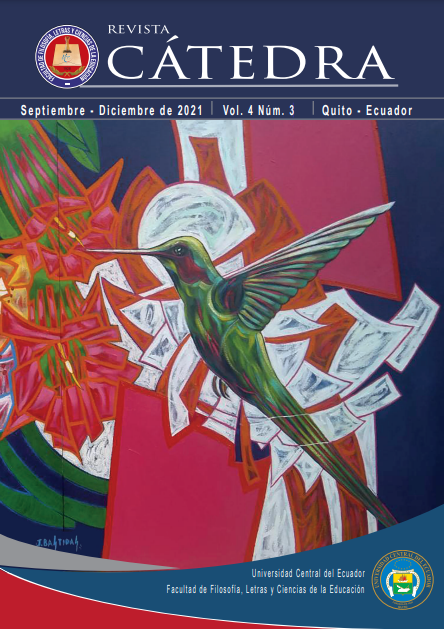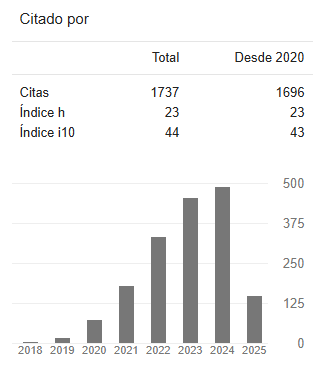The use of TransLanguage to improve oral reading proficiency in a foreign language classroom
DOI:
https://doi.org/10.29166/catedra.v4i3.3041Keywords:
foreign classroom, oral reading proficiency, translanguagingAbstract
Translanguaging is an approach that sees no boundaries between languages and allows their simultaneous use when teaching and learning a new language, therefore, it can be used as a scaffold device to develop a foreign language since it helps students clarify terms and make meaning. Nevertheless, it is a relatively recent term in Latin America, and investigations related to it are scarce. The main objective that guided this study was to apply translanguaging during English classes in a private High School to improve the students´ oral reading proficiency. A pre and post-tests were taken at the beginning and the end of one unit (which lasted 6 weeks) where students read a 300-word passage and words read correctly within a minute were counted. Also, a Likert-scale survey was applied to students and a teacher to know their experiences and perceptions after the application of translanguaging. A t-test was carried out and the results showed an improvement in the students´ oral reading proficiency (Mean = 221.55 in the pre-test and Mean = 243.22 in the post-test with a standard deviation of 42.20 and 30.20 respectively) after the usage of this approach with a difference statistically significant (p > 0.001). The mean of words read correctly increased in the post-test (M = 21.68; SD = 18.88). The use of translanguaging probably had a positive result on the skill studied and also in the students and teacher´s experiences when using translanguaging.
Downloads
References
Adinolfi, L., & Astruc, L. (2017). An exploratory study of translanguaging practices in an online beginner-level foreign language classroom. CercleS, 7(1), 185 – 204. https://doi.org/10.1515/cercles-2017-0008
Canagarajah, S. (2011). Translanguaging in the Classroom: Emerging Issues for Research and Pedagogy. Applied Linguistics Review, (2), 1-28. https://doi.org/10.1515/9783110239331.1
Carroll, K., & Sambolín, A. (2016). Using university students´ L1 as a resource: Translanguaging in a Puerto Rican ESL classroom. Bilingual Research Journal, 39(3-4), 248 – 262. https://doi.org/10.1080/15235882.2016.1240114
Celic, C., & Seltzer, K. (2013). Translanguaging: a Cuny-Nysieb Guide for Educators. https://www.cuny-nysieb.org/wp-content/uploads/2016/04/Translanguaging-Guide- March-2013.pdf
Celic, C., & Seltzer, K. (2016). El translenguar: una guía de Cuny-Nysueb par aEducadores. Versión abreviada en español. https://www.cuny-nysieb.org/wp-content/uploads/2016/09/La-Guia-del-Translenguar-En-Espanol-Setiembre-2016.pdf
Cenoz, J., & Gorter, D. (2017). Minority languages and sustainable translanguaging: threat or opportunity? Journal of Multilingual and Multicultural Development, 38(10), 901- 912. https://doi.org/10.1080/01434632.2017.1284855
Cenoz, J., & Gorter, D. (2020). Teaching English through pedagogical translanguaging. World Englishes, 39(2), 300-311. https://doi.org/10.1111/weng.12462
Creese, A., & Blackledge, A. (2010). Translanguaging in the Bilingual Classroom: A Pedagogy for Learning and Teaching? The Modern Language Journal, 94(1), 103 – 115. https://www.jstor.org/stable/25612290
Cummins, J. (2007). Rethinking monolingual instructional strategies in multilingual classrooms. Canadian Journal of Applied Linguistics, 10(2), 221–240. https://journals.lib.unb.ca/index.php/CJAL/article/view/19743
Dahlberg, A. (2017). Translanguaging as a scaffolding structure in a multilingual group studying English in Sweden [Bachelor´s dissertation, University of Gävle Swedish] http://www.diva-portal.org/smash/record.jsf?pid=diva2%3A1083686&dswid=-1342
Esquinca, A., Araujo, B., & de la Piedra, M. (2014). Meaning making and Translanguaging in a two-way dual-language program on the U.S –Mexico Border. Bilingual Research Journal: The Journal of the National Association for Bilingual Education, 37(2), 164 – 181. http://www.tandfonline.com/loi/ubrj20
Fallas, C., & Dillard-Paltrineri, E. (2015). Professors´ and Students´ Conflicting Beliefs about Translanguaging in the EFL Classroom: Dismantling the Monolingual Bias. Revista de Lenguas Modernas, (23), 301-328. 10.15517/rlm.v0i23.22355
Flores, N., & García, O. (2013). Linguistic third spaces in education: Teachers’ translanguaging across the bilingual continuum. https://ofeliagarciadotorg.files.wordpress.com/2014/01/linguistic-third-spaces-in-education.pdf
Galante, A., Okubo, K., Cole, C., Elkader, N., Carozza, N., Wilkinson, C., Woton, C., & Vasic, J. (2020). “English-only is not the way to go”: Teachers´ perceptions of plurilingual instruction in an English Program at a Canadian University. Tesol Quarterly, 54(2), 980 – 1009. https://doi.org/10.1002/tesq.584
García, O. (2020). Translanguaging and latinx bilingual readers. The Reading Teacher, 73(5), 557-562. https://doi.org/10.1002/trtr.1883
García, O., & Wei, L. (2014). Translanguaging: Language, bilingualism and education. Palgrave Macmillan UK. https://doi.org/10.1057/9781137385765
García, O., & Wei, L. (2018). Translanguaging. The Encyclopedia of Applied Linguistics. 1- 7. 10.1002/9781405198431.wbeal1488
Hungwe, V. (2019). Using translanguaging approach in teaching paraphrasing to enhance reading comprehension in first-year students. Reading & Writing – Journal of the Reading Association of South Africa, 10(1), e1-e9. https://doi.org/10.4102/rw.v10i1.216
Infante, P., & Licona, P. (2018). Translanguaging as pedagogy: developing learner scientific discursive practices in a bilingual middle school science classroom. International Journal of Bilingual Education and Bilingualism. 1-14. https://doi.org/10.1080/13670050.2018.1526885
Lasagabaster, D., & García, O. (2014). Translanguaging: towards a dynamic model of bilingualism at school/ Translanguaging: hacia un modelo dinámico de bilinguismo en la escuela. Cultura y Educación: Culture and Education, 26(3), 557 – 572. 10.1080/11356405.2014.973671
Lewis, G., Jones, B., & Baker, C. (2012). Translanguaging: origins and development from school to street and beyond. Education Research and Evaluation: An International Journal on Theory and Practice, 18(7), 641 – 654. 10.1080/13803611.2012.718488
Licona, R., & Gregory, J. (2019). Translanguaging in a middle school science classroom: constructing scientific arguments in English and Spanish. Cultural Studies of Science Education.15, 485 – 510. https://doi.org/10.1007/s11422-019-09946-7
Machado, J. (2019, December). Ecuador tiene el peor nivel de inglés de América Latina. Primicias. https://www.primicias.ec/noticias/sociedad/idioma-ingles-estudiantes-convenio-educacion-profesores/
Makalela, L. (2015a). Moving out of linguistic boxes: the effects of translanguaging strategies for multilingual classrooms. Language and Education, 29(3), 200 – 217. http://dx.doi.org/10.1080/09500782.2014.994524
Makalela, L. (2015b). Translanguaging as a vehicle for epistemic access: cases for reading comprehension and multilingual interactions. Per Linguam, 31(1), 15-29. http://dx.doi.org/10.5785/31-1-628
Nagy, T. (2018). On Translanguaging and its role in Foreign Language Teaching, Acta Universitatis Sapientiae, Philologica, 10(2), 41-53. https://doi.org/10.2478/ausp-2018-0012
Nielsen, J. (2018). Foreign students and their learning Spanish process: first hint of translanguaging. Alfa: Revista de Lingüística (São José Rio Preto), 62(1), 53 – 71. https://doi.org/10.1590/1981-5794-1804-3
Nikula, T., & Moore, P. (2016). Exploring transnlanguaging in CLIL. International Journal of Bilingual Education and Bilingualism, 22(2), 237-249. https://doi.org/10.1080/13670050.2016.1254151
Ortega, Y. (2019). “Teacher, ¿Puedo Hablar en Español?” A Reflection on Plurilingualism and Translanguaging Practices in EFL. Issues Teach. Prof. Dev, 21(2), 155-170. https://doi.org/10.15446/profile.v21n2.74091
Pacheco, M., & Miller, M. (2016). Making Meaning through translanguaging in the Literacy Classroom. The Reading Teacher, 69(5), 533 – 537. https://www.jstor.org/stable/44002002
Palmer, D., Martínez, R., Mateus, S., & Henderson, K. (2014). Reframing the debate on language separation: toward a vision for translanguaging pedagogies in the Dual Language Classroom. The Modern Language Journal, 98(3), 757- 772. 10.1111/j.1540-4781.2014.12121.x
Portolés, L., & Martí, O. (2016). Translanguaging as a teaching resource in early language learning of English as an additional language (EAL). Bellaterra Journal of Teaching & Learning Language & Literature, 10(1), 61 – 77. http://dx.doi.org/10.5565/rev/jtl3.698
Valdiviezo, E. (2019). The Effects of the Integration of Translanguaging as a Pedagogical Strategy in the EFL University Classroom [Master´s thesis, Universidad de Cuenca]. http://dspace.ucuenca.edu.ec/handle/123456789/32882
Wang, D. (2016). Translanguaging In Chinese foreign language classrooms: students and teachers´ attitudes and practices. International Journal of Bilingual Education and Bilingualism, 22(2), 138 - 149. https://doi.org/10.1080/13670050.2016.1231773
Wei, L. (2017). Translanguaging and the Goal of TESOL. https://www.tesol.org/docs/default- source/ppt/li-wei.pdf
Yilmaz, T. (2019). Translanguaging as a pedagogy for equity of language minoritized students. International Journal of Multilingualism, 1-20. https://doi.org/10.1080/14790718.2019.1640705
Downloads
Published
Versions
- 2021-10-22 (2)
- 2021-09-28 (1)









